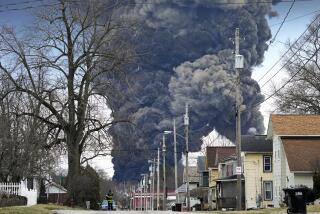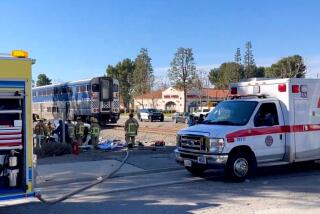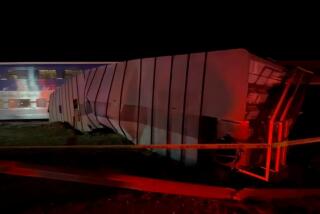Rail fractures, defects caused 2013 Canadian train derailment
A Canadian National oil train derailment and fire in October 2013 was caused by rail fractures and other defects, according to a report released Tuesday by the Transportation Safety Board.
The train derailed as it traveled through a curve in Gainford. A break had occurred in a rail scheduled for replacement in 2015, according to the report.
The rail fragmented because of a number of defects along the length, which came from high traffic density and loading in the area, according to the report. A rail flaw detection test that utilizes an ultrasonic sound signal had been conducted two months earlier, but had not identified the problems.
“It’s these poor surface conditions that generate these types of defects and then they prevent you from finding them,” said George Fowler, track and infrastructure specialist for the Transportation Safety Board.
The Canadian National Railway freight train, which was traveling from Edmonton, Alberta, to Vancouver, British Columbia, was carrying petroleum crude oil and liquefied petroleum gas. Thirteen cars were derailed, 600 feet of track destroyed and a house near the derailment site was damaged by the fire. There were no injuries.
The report comes about a week after two major train derailments -- one in West Virginia and one in Ontario, Canada -- that resulted in intense fires and raised safety questions about moving oil by train. One person was treated for potential smoke inhalation in West Virginia; in Ontario, there were no injuries. A derailment in Lac-Megantic, Quebec, in July 2013 killed 47 people.
Tuesday’s report answers some, but not all, questions about the cause of train derailments. A number of derailments have been attributed to rail fractures, according to the report.
Oil trains are increasingly being used to ship crude oil from the rapidly developing oil sands of northern Alberta, and also from North Dakota’s Bakken oil fields and Montana, because of the lack of pipeline capacity.
On Tuesday, President Obama vetoed a bill authorizing the Keystone XL pipeline, which could have made oil train shipments less necessary.
After the October 2013 derailment, Canadian National conducted walking inspections and conditions on certain tracks were tested, according to the report.
“What they have to do is try to ensure that the rail surface is in good condition,” Fowler said.
For more news, follow @smasunaga.
More to Read
Start your day right
Sign up for Essential California for news, features and recommendations from the L.A. Times and beyond in your inbox six days a week.
You may occasionally receive promotional content from the Los Angeles Times.







